Pluto’s characteristic heart-shaped feature may have been formed by an ancient impact, scientists have discovered.
This enormous region of the dwarf planet’s surface—first seen in detail by the New Horizons flyby in 2015—is named Tombaugh Regio and has mystified astronomers for years due to its strange shape and geological composition.
Now, researchers from the University of Bern, the National Center of Competence in Research (NCCR) PlanetS, and the University of Arizona say they have “solved” the mystery. They believe it was formed by a huge, slow object hitting Pluto at a strange angle, according to a new paper in the journal Nature Astronomy.
Tombaugh Regio is the largest bright surface feature on Pluto and measures about 1,000 miles across. It was named for astronomer Clyde Tombaugh, who discovered the dwarf planet in 1930. The western lobe of the heart is named Sputnik Planitia, which is several miles lower in altitude than its surroundings and is covered in nitrogen, carbon monoxide, and methane ice. This ice reflects sunlight, appearing bright to observers on Earth.
“The bright appearance of Sputnik Planitia is due to it being predominantly filled with white nitrogen ice that moves and convects to constantly smooth out the surface. This nitrogen most likely accumulated quickly after the impact due to the lower altitude,” study lead author Harry Ballantyne, a researcher at the University of Bern, said in a statement.
According to the new paper, Sputnik Planitia may have been created after a massive collision with a celestial body approximately 435 miles across, about the width of California.
“The elongated shape of Sputnik Planitia strongly suggests that the impact was not a direct head-on collision but rather an oblique one,” co-author Martin Jutzi, a researcher at the University of Bern, said in the statement.
The researchers used the Smoothed Particle Hydrodynamics (SPH) simulation software to digitally simulate collisions with the dwarf planet, adjusting variables like the composition of both Pluto and the impacting body, as well as the impactor’s speed and angle. These simulations validated the researchers’ theory regarding the slanted impact angle and helped them identify the likely composition of the impacting object.
“Pluto’s core is so cold that the rocks remained very hard and did not melt despite the heat of the impact, and thanks to the angle of impact and the low velocity, the core of the impactor did not sink into Pluto’s core, but remained intact as a splat on it,” said Ballantyne.
This slow impact speed and odd angle also likely caused the strange heart shape of the region, as a faster and more direct impact would have resulted in a symmetrical crater.
“We are used to thinking of planetary collisions as incredibly intense events where you can ignore the details except for things like energy, momentum and density. But in the distant Solar System, velocities are so much slower, and solid ice is strong, so you have to be much more precise in your calculations. That’s where the fun starts,” co-author Erik Asphaug, a researcher from the University of Arizona, said in the statement. “Somewhere beneath Sputnik is the remnant core of another massive body, that Pluto never quite digested.”

NASA natural-color images of Pluto, showing the colors that the human eye would perceive. NASA/Johns Hopkins University Applied Physics Laboratory/Southwest Research Institute/Alex Parker
These findings indicate that Pluto’s internal composition differs from earlier expectations, suggesting the absence of a subsurface ocean. Pluto has been long theorized to have a liquid water ocean beneath its surface, which would have explained why the Sputnik Planitia region was located near the equator of the planet. This new theory suggests that Sputnik Planitia was the site of an impact, and therefore doesn’t require the presence of a subsurface ocean.
“In our simulations, all of Pluto’s primordial mantle is excavated by the impact, and as the impactor’s core material splats onto Pluto’s core, it creates a local mass excess that can explain the migration toward the equator without a subsurface ocean, or at most a very thin one,” said Jutzi.
Do you have a tip on a science story that Newsweek should be covering? Do you have a question about Pluto? Let us know via [email protected].
Related Articles
Start your unlimited Newsweek trial
News Related-
Russian court extends detention of Wall Street Journal reporter Gershkovich until end of January
-
Russian court extends detention of Wall Street Journal reporter Evan Gershkovich, arrested on espionage charges
-
Israel's economy recovered from previous wars with Hamas, but this one might go longer, hit harder
-
Stock market today: Asian shares mixed ahead of US consumer confidence and price data
-
EXCLUSIVE: ‘Sister Wives' star Christine Brown says her kids' happy marriages inspired her leave Kody Brown
-
NBA fans roast Clippers for losing to Nuggets without Jokic, Murray, Gordon
-
Panthers-Senators brawl ends in 10-minute penalty for all players on ice
-
CNBC Daily Open: Is record Black Friday sales spike a false dawn?
-
Freed Israeli hostage describes deteriorating conditions while being held by Hamas
-
High stakes and glitz mark the vote in Paris for the 2030 World Expo host
-
Biden’s unworkable nursing rule will harm seniors
-
Jalen Hurts: We did what we needed to do when it mattered the most
-
LeBron James takes NBA all-time minutes lead in career-worst loss
-
Vikings' Kevin O'Connell to evaluate Josh Dobbs, path forward at QB
